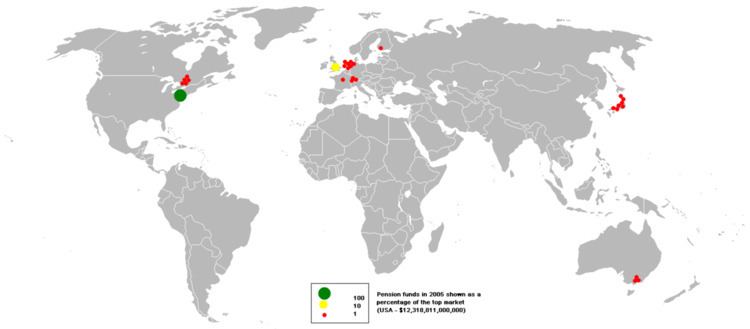 | ||
A pension fund, also known as a superannuation fund in some countries, is any plan, fund, or scheme which provides retirement income.
Contents
- Open vs closed pension funds
- Public vs private pension funds
- Government
- Industry not for profit
- Private
- Brazil
- Chile
- China
- Hong Kong
- India
- Japan
- Malaysia
- Morocco
- Nepal
- Netherlands
- Norway
- Romania
- Saudi Arabia
- Singapore
- Switzerland
- United States
- References
Pension funds typically have large amounts of money to invest and are the major investors in listed and private companies. They are especially important to the stock market where large institutional investors dominate. The largest 300 pension funds collectively hold about $6 trillion in assets. In January 2008, The Economist reported that Morgan Stanley estimates that pension funds worldwide hold over US$20 trillion in assets, the largest for any category of investor ahead of mutual funds, insurance companies, currency reserves, sovereign wealth funds, hedge funds, or private equity.
The Federal Old-age and Survivors Insurance Trust Fund is the world's largest public pension fund which oversees $2.645 trillion USD in assets.
Open vs. closed pension funds
Open pension funds support at least one pension plan with no restriction on membership while closed pension funds support only pension plans that are limited to certain employees.
Closed pension funds are further subclassified into:
Public vs. private pension funds
A public pension fund is one that is regulated under public sector law while a private pension fund is regulated under private sector law.
In certain countries the distinction between public or government pension funds and private pension funds may be difficult to assess. In others, the distinction is made sharply in law, with very specific requirements for administration and investment. For example, local governmental bodies in the United States are subject to laws passed by the states in which those localities exist, and these laws include provisions such as defining classes of permitted investments and a minimum municipal obligation.
Government
Industry (not-for-profit)
Private
Brazil
Government
Private
Chile
China
Government
Private
Hong Kong
India
Japan
Malaysia
Morocco
Nepal
Netherlands
Norway
Romania
The pension system in Romania is made of 3 pillars, one is the state pension (Pillar I - Mandatory), second is a private mandatory pension were the state transfers a percentage of the contribution it collects for the public pension and third an optional private pension (Pillar III - Voluntary).
The Financial Supervisory Authority - Private Pension is responsible for the supervision and regulation of the private pension system.
Saudi Arabia
Singapore
Switzerland
Government
Social Security Institution was established by the Social Security Institution Law No:5502 which was published in the Official Gazette No: 26173 dated 20.06.2006 and brings the Social Insurance Institution, General Directorate of Bağ-kur and General Directorate of Emekli Sandığı whose historical development are summarized above under a single roof in order to transfer five different retirement regimes which are civil servants, contractual paid workers, agricultural paid workers, self-employers and agricultural self-employers into a single retirement regime that will offer equal actuarial rights and obligations. The Social Security Institution is continuing its activities to provide better quality of services for our citizens with the participation of whole staff putting all their energy individually and institutionally.
Private
OYAK (Ordu Yardımlaşma Kurumu/Armed Forces Pension Fund) provides its members with "supplementary retirement benefits" apart from the official retirement fund, T.C.Emekli Sandığı/SSK, to which they are primarily affiliated.
In addition to the retirement benefit, OYAK pays "disability benefits" to the members on duty when they become partially or fully disabled as well as "death benefits" to the heirs of the deceased member if the death occurs during the member's subscription to the Foundation.
OYAK is incorporated as a private entity under its own law subject to Turkish civic and commercial codes. OYAK while fulfilling its legal duties, as set in the Law, also provides its members with social services such as loans, home loans and retirement income systems.
The initial source of OYAK's funds is a compulsory 10 percent levy on the base salary of Turkey's 200,000 serving officers who, together with 25,000 current pensioners, make up OYAK's members.
Some other Turkish private pension funds:
United States
In the United States pension funds include schemes which result in a deferral of income by employees, even if retirement income provision isn't the intent. The United States has $24.5 trillion in retirement and pension assets ($15.5 trillion in private funds, $9 trillion in public funds) as of June 30, 2014. The largest 200 pension funds accounted for $4.540 trillion as of September 30, 2009.
